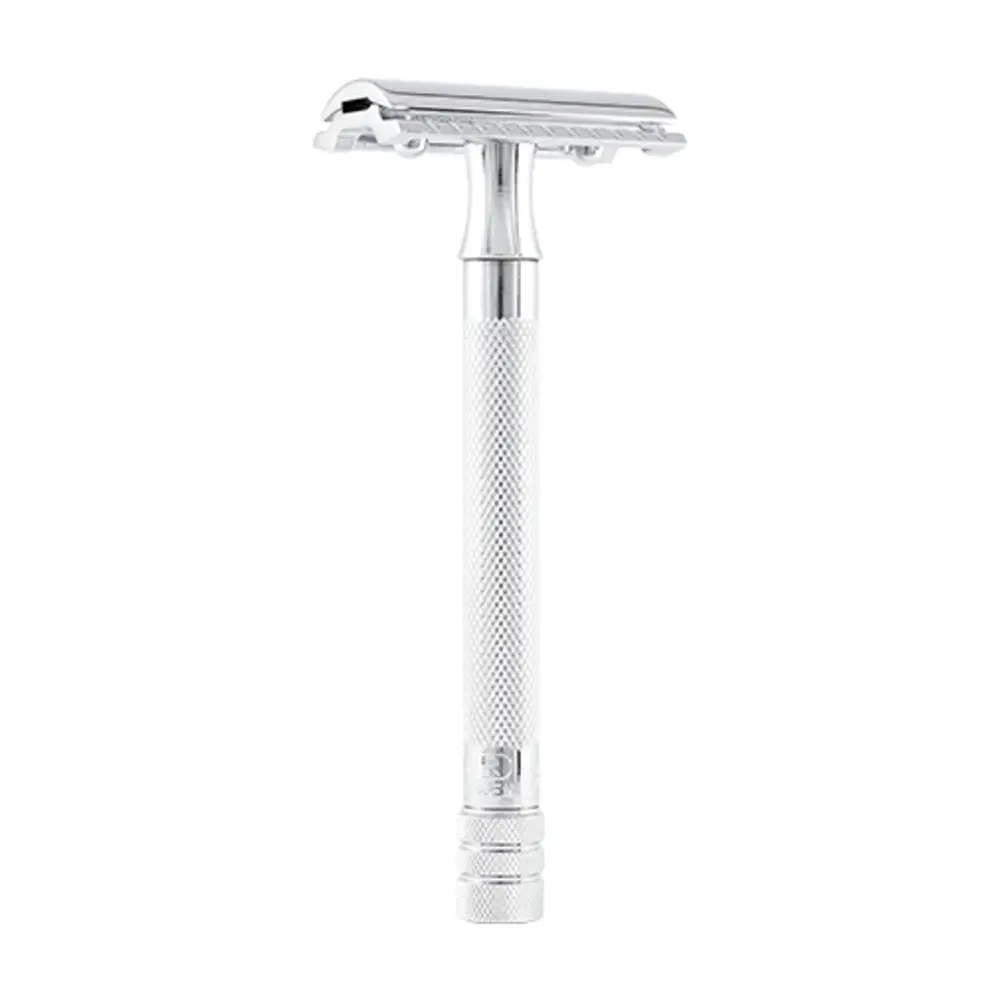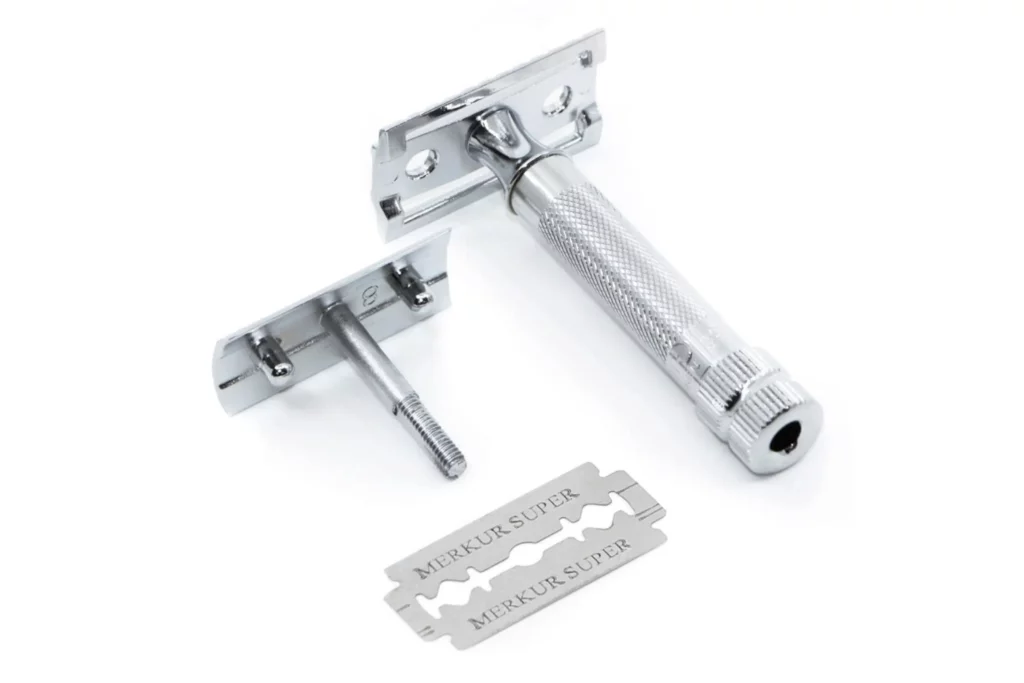Safety razors offer many key advantages when compared to more modern cartridge razors. To choose the best safety razor for you, consider factors like handle length, weight, blade gap, comb style, and your budget. Also, keep in mind your personal shaving preferences and skin sensitivity.
We’ll be sharing some key tips on picking out the right safety razor for you.
5 Things to Look for When Choosing a Safety Razor

When selecting a new safety razor, there are several factors to consider. However, here are the most important that’ll ensure a smooth, comfortable shave:
- Handle Length: The handle length of a safety razor can affect control and comfort during shaving. Some people prefer shorter handles for better maneuverability, while others opt for longer handles for extra grip and leverage. It’s a good idea to try holding different handle lengths to determine which feels most comfortable and natural for you. Broadly speaking, those with larger hands may prefer longer handles, while individuals with smaller hands may lean towards shorter ones.
- Weight: The weight of a safety razor can impact the pressure applied during shaving. Heavier razors require less pressure, providing a smoother shave and reducing the risk of irritation, razor burn, and nicks. Lighter razors, on the other hand, offer more control and may be easier for beginners to handle.
- Blade Gap and Blade Exposure: The blade gap refers to the space between the razor’s blade and its safety bar, while blade exposure is the amount of blade visible and available to shave. A larger blade gap and exposure provide a more aggressive shave, which may be suitable for those with thicker hair or who shave less frequently. Conversely, a smaller blade gap and exposure offer a gentler shave and is ideal for those with sensitive skin or who shave daily. Finding the right balance between aggressiveness and comfort is crucial for an enjoyable shaving experience. Adjustable razors offer a varying blade gap and exposure and may be a good choice for those looking to experiment with different levels of aggressiveness.
- Comb: Safety razors come in two main comb styles: open and closed. For beginners or those with sensitive skin, a closed comb safety razor might be the best option, as it provides more protection and reduces the likelihood of nicks, cuts, and ingrown hairs. However, if you are more experienced or have thicker facial hair, an open comb design can offer a more aggressive and efficient shave. A variation on the closed comb, slant bar razors can also provide a more aggressive shave due to their angled cutting approach, while still offering some protection to the skin.
- Price: Safety razors can vary greatly in price, from budget-friendly options to luxury, high-end models. Determine a budget that you’re comfortable with and consider the overall quality, durability, and performance of the razors within that range. Remember that investing in a good quality safety razor can save you money in the long run, as they often last for years and require only inexpensive replacement blades, in contrast to disposable cartridges.
Ultimately, picking a safety razor is a personal decision based on your individual needs, preferences, and budget. By considering these factors and understanding the various options available, you can find a safety razor that will provide you with a comfortable, close, and enjoyable shaving experience.
Does the Brand Matter?
From Feather to Merkur, Edwin Jagger to Mühle, there are many reputable safety razor manufacturers available. While brand recognition can be a helpful indicator of quality and reliability, it’s important not to focus solely on the brand name. Instead, consider the specific features, materials, and craftsmanship of each razor.
Companies like Feather are highly regarded in the wet shaving community for producing sharp, high-quality blades, while Merkur and Edwin Jagger are known for their reliable beginner-friendly razors that are modestly priced.
How Much Weight Should You Put in Online Reviews?
Evaluating online reviews for safety razors is difficult because personal preferences and experiences can greatly impact an individual’s opinion. While it’s useful to read reviews for insight into durability, construction, and overall performance, it’s crucial to remember that everyone’s shaving preferences, beard type, and skin sensitivities are different. Use online reviews as a guideline, but don’t rely solely on them to make your decision.
If you want to put weight on some reviews, we recommend looking strictly at the facial hair type and skin sensitivity of the reviewers. This will help you gather information from people with similar shaving needs as yours, giving you a better idea of how the safety razor might perform for you. Additionally, prioritize reviews from reputable sources or experienced wet shavers who can provide in-depth information and comparisons between various razors.
Forums such as Badger & Blade and The Shave Den can also be helpful resources, as they provide a platform for the wet shaving community to share their experiences.
Other Things to Look For

Aside from the basic factors mentioned earlier, there are also some detailed nuances that can make a difference in your shaving experience. These may include the texture and grip of the handle, the overall balance of the razor, the materials used in its construction, and the razor’s aesthetics.
- Number of Pieces: Safety razors come in one, two, or three-piece designs. One-piece razors, also known as twist-to-open or butterfly razors, are convenient and easy to load but may break due to moving parts. Two and three-piece razors offer more precise blade alignment and generally better construction – they are also easier to clean.
- Texture and Grip: A good grip on your razor is essential for maintaining control and avoiding accidental slips during shaving. Look for handles with textured patterns, knurling, or rubberized coatings, which can improve grip and reduce the chance of dropping the razor.
- Balance: A well-balanced razor can make shaving more comfortable and efficient, as it allows for smoother strokes and better control. When selecting a safety razor, consider how the weight is distributed between the handle and the head. Ideally, the razor should feel comfortable and easy to maneuver in your hand without putting strain on your wrist or fingers.
- Materials: The materials used in a safety razor’s construction can greatly impact its durability, weight, and overall feel. Common materials include stainless steel, brass, zinc alloy, and aluminum. Stainless steel and brass razors are often more durable and heavier, providing a solid feel and long-lasting performance. On the other hand, zinc alloy and aluminum razors tend to be lighter and more affordable but may not be as durable in the long run.
- Aesthetics: While aesthetics may not directly impact the performance of a safety razor, it can be an important factor for some users. From classic chrome designs to sleek black finishes, and even intricate patterns, there is a wide range of styles available to suit individual tastes. Choosing a razor that appeals to your personal style can enhance your overall shaving experience and make it more enjoyable.
- Razor Blade Compatibility: While most safety razors are compatible with standard double-edge blades, there may be some variations in blade fitting, particularly with more unique or vintage razors. Additionally, you might find single edge or injector razors that require specific blade types. Ensure that the razor you choose is compatible with the blades you plan to use or readily available blade options, as this will ensure a consistent and hassle-free shaving experience.